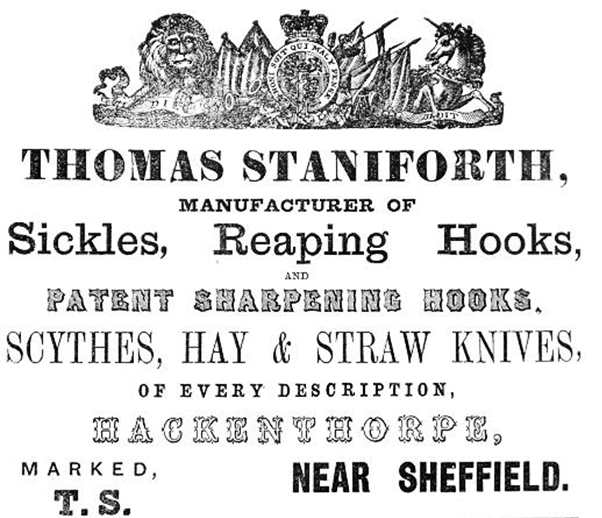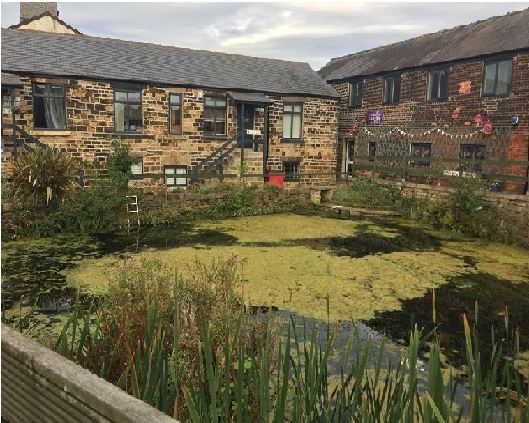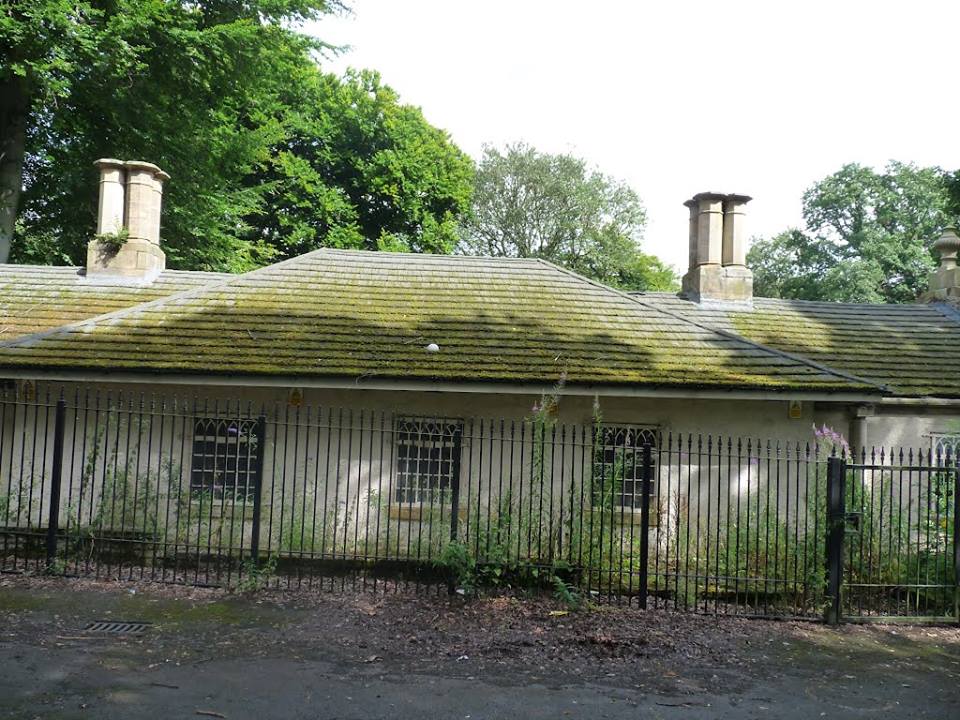
Thomas Staniforth & Co. Sickle works at Hackenthorpe.
 Thomas' mark on his will dated 1847
Thomas' mark on his will dated 1847
Thomas Staniforth III of Hackenthorpe was baptised on the 20th January, 1785 at St. Mary’s Beighton. Based on the cutlers apprentice records, Thomas Staniforth the son of Thomas Staniforth of Hackenthorpe gained his freedom In 1810. The apprentice records fail to note the Master, although it was highly likely he was apprenticed to his father, although since his father passed away in 1808, it seems his final two years were served under another Master, likely an uncle.
In 1807 Thomas married Ann Hibbard, the daughter of George Hibbard. The Hibbard family is an interesting one, as we shall later see that they marry into the Staniforth’s in later generations.
Although it is not certain when Thomas took over the running of the Sickleworks, it is clear in his father’s will that he requested that his wife, Sarah Hurt make the decisions upon his death, so it is likely that Thomas was running the business around 1810.
It should be noted that a few years prior to this year the Cliff Wheel was constructed on the Shire Brook at Beighton by George and Thomas Hutton. In 1809 this wheel was being shared by both Staniforth’s and Hutton’s.
By 1818, the Napoleonic wars had come to an end and we see evidence of Thomas applying for a new lease on the Carr Forge Scythe wheel, which at this time was owned by the Inkersall family. This was also the same wheel his grandfather used decades earlier. It seems there was some issues with William Inkersall, the owner at the time, who claimed the wheel had been built/rebuilt by his father George Inkersall. Thomas put in a successful application to lease the wheel however we see evidence of Thomas writing to the Earl Manvers agent, Mr Pickin explaining that Mr. Inkersall was refusing to sign the required receipts, and that he believed that Mr. Inkersall would write to the Earl Manvers claiming that the ‘Wheel has been taken from him and is now let to another person for less value than he would give…Tho he dies not know exactly how much I do pay’. He was also claiming reimbursements for fencing that had been done.
Mr. Pickin had already had prior dealings with Mr. Inkersall and it appears that he had written to him a week prior over the fencing issue in which he was told he paid him ‘more by upwards of two hundred pounds than he would have received in any court of law’. He also explained to him that if he did not ‘give up the possession of the wheel, sign the receipt and pay half years rent’ he would take legal proceedings.
This isn’t he last time Thomas Staniforth would have to contact Mr. Pickin over one of his neighbours, the following year he is forced to report John Jubb, farmer and maltster who had just moved into Drake House. John wasted no time and claimed the right to make a ‘foot road’ across not only his land, but also the adjoining plot which belonged to Thomas Staniforth. Thomas again reported this issue to Mr. Pickin, who sent John Jubb a letter stating:
‘I am informed that you claim and persist in making a foot road across certain lands in the occupation of Mr. Thomas Staniforth, notwithstanding you have been repeatedly assured there is no road in this direction. I beg to refer you to the Act and award for the enclosure of the parish of Beighton, which I conceive must afford you convincing proof that no road can legally be made in the direction you attempt on. I have given the tenant orders to prevent any road being made across his lands and am prepared by every legal means to resist any future attempt for so doing’.
Mr. Jubb appears to have listened to the response, however five years later he purchased more land and again he was reported by Mr. Green who appealed to Mr. Pickin regarding Mr. Jubb attempting to build a road across his land.
By the 1820s Thomas was making extensions to his workshops at Hackenthorpe. In Mr. Pickin’s notebook we see him asking ‘What did Thomas Staniforth pay for stone he got from Dent Lane to build his Blacksmiths Shops and smithys with?’ There is no response noted. It was also around this time that Thomas introduced steam power to the workshops, he had purchased a Condensing Beam Engine from Peel and Williams of Ancoats, Manchester. This made production more efficient, as his workers would no longer have to make the trip down to the Shire Brook to grind blades before returning. Two tall chimneys were constructed which dominated the skyline of the small village of Hackenthorpe, and a smithy pond was built in the courtyard which provided the water supply.
In 1825 Thomas was nominated by ballot to serve in the Militia. This was a mandatory position where a man was chosen each year by a ballot. The parish constable would compile al ist of all able-bodied men between the ages of eighteen and forty-five and from this list a ballot was taken to choose men for the Militia. The men chosen had to serve for five years and would have to spend two to three weeks each year at a training camp. Thomas clearly did not wish to take on such a position, and instead realized that his work required his full attention, especially with the newly modernized equipment being put in place. He instead put a substitute in his place, an eighteen year old man from Chesterfield named George Bacon. George was a Frame Work Knitter.
This same year we also find John Jubb of Drake House marrying Olivia Staniforth, a daughter of John Staniforth, a miller from Beighton, however we will look at John in later chapters as their daughter Jane Jubb would marry Henry Staniforth, Thomas’ son.
In 1826, we find Thomas’s Sister Jane marrying William Cardwell, a widower. Together they had a number of sons, including Richard Cardwell born in 1831. Richard I goes onto become a ‘Clerk in a Steel Manufactory’ as recorded on the 1861 Census, and it appears that the firm was Thomas Firth & Sons based at the Norfolk Works on Saville Street East, Sheffield. A couple of years following the Census, Richard is named on a list of school managers at Gleadless School. It appears that decades later, Richard also had shares in the New Inn at Hackenthorpe, which at that time was owned by the Staniforth family, and also Greenside House which Thomas Staniforth was listed as a freeholder in 1827. It is unclear as to when the Staniforth family purchased Greenside House, but it is clear they are living here by the mid-1820s. Thomas added the Bay windows and a store. The house was on land adjoining his workshops, and still stands to this day, as a Grade-II listed building.
 Thomas Staniforth & Co. Sickleworks in October 2017.
Thomas Staniforth & Co. Sickleworks in October 2017.
In 1827, Thomas became one of the assistants of the Cutlers Company, following in his father’s footsteps. He would hold this position almost continuously until his death. The mid-19th Century was a tough time for the Cutlers Company, with many new businesses and industry growing in the city of Sheffield, the Cutlers lost a lot of the authority they once had. Fewer meetings were held and less and less cutlers were applying for new marks.
The start of the 19th Century was a tough time in the country, especially for those working in Agriculture.
William Cobett, MP and Journalist made a Northern Tour in early 1830 and reported the following:
Sheffield 31st January 1830:
Whatever other nations may do with cotton and with wood, they will never equal England with regard to things made of iron and steel. We are here just upon the borders of Derbyshire, a nook of which runs up and against Yorkshire from Nottinghamshire. I went to a village, the day before yesterday called Mosborough, the whole of the people of which are employed in the making of Sickles and Scythes and where I was told they are very well off even in these days.
Due to Mosborough being a neighbouring village with Hackenthorpe it seems safe to assume Hackenthorpe was seen in the same light my Mr. Cobbett, especially due to them both having the same booming Sickle and Scythe smithing trade.
In 1830 Thomas’ daughter Mary, a single woman that was aged seventeen at this time, fell pregnant. She had a son named Francis Staniforth that year, and he was baptised in the neighbouring parish of Handsworth on November 15th of that year. The baptism record shows that the father’s name was recorded as ‘Erasmus Steele’. A man bearing this name appears on the White’s Directory of Sheffield in 1845 where he is described as being a ‘Steel melter’ living at 89 Rockingham Street.
As was common during this time period, Mary being an unwed mother would mean she was sent away from the parish, likely to her mother’s family at Woodhouse, Handsworth during her pregnancy. By 1836 Mary is living with her parents again, however it appears Francis was raised by John and Elizabeth Ward at Woodthorpe Commonside. He appears in this household on the 1841 Census, along with John and Elizabeth’s children, John and Sarah.
This whole affair seems to have been pushed to the back of Thomas’s mind, besides, he had plenty to keep himself occupied in his workshops. By now he had upwards of four or five tedding machines operating, each costing roughly £40. This allowed for 800 teeth to be struck every minute. They were also still occupying the Cliff Wheel in Beighton at this time, and by 1832 they were also leasing both the Carr Wheel and the newer Rainbow Forge Wheel. It seems likely they were also still sharing the Upper and Lower Sickle wheels with the Hutton’s of Ridgeway.
Thomas’ name appears on the Beighton Electors for 1836-7, and when the 1841 Census was recorded, he and his wife had six children with them in the household. They had four sons at this time, Alfred, a grocer, Mark a sickle maker, and two sons under the working age, Hugh and John. Two daughters Mary and Sarah are also with them.
It is also interesting to note that they had six servants with them, Joseph Whitehead, Thomas Smalley, John Holdsworth, Aron Wilson and two girls Ann Binney and Mary Foster. Thomas’ eldest son Thomas had moved out of the parental home by this stage, and was living with his wife Mary Jane (nee Hardy), who is recorded simply as Jane Staniforth. Thomas and Mary Jane had two children with them, three year old Sarah and a baby William Staniforth. Jane Booker is also in the household working as a maid, and Thomas has an apprentice, William Staniforth. This is very likely William Staniforth, son of George Staniforth and Ann Barker. This particular George has been a mystery to many researchers including the late Rosamund Du Cane, who came to the conclusion that he was the brother of Thomas Staniforth II, however no baptism record exists on the Beighton St. Mary’s register.
Thomas Staniforth’s mother, Sarah Hurt (Wife of Thomas Staniforth II) is also still living at the time of the 1841 Census. By this stage she is aged seventy-eight and is living with her widowed daughter, Sarah Ward.
In 1843 we must direct our attention to Birley Spa. In the local area there is a strong belief that there was once a Roman Spa in Birley, just outside of Hackenthorpe village. T.L Platts, the late local historian notes in his own writings that the first recorded mention of a span was in a book titled ‘The Mineral Waters of England’ by Dr. Thomas Short of Sheffield. There is also evidence of Quakers operating a Spa in the area in the late 1600s, and a memorial stone for a man named Sutcliffe was found with the date 1701 engraved.
 Birley Spa in 2012
Birley Spa in 2012
In 1842 the Earl Manvers wanted to develop there and rebuild the bath house, with plans to also include a hotel. Plans show that the ground was to be landscaped to include seven grottos, with two bridges over the stream which flowed through the spa and down through the valley before flowing into the Shire Brook. A description can be found in directories which state ‘a respectable and commodious establishment ith seven baths of various dimensions… situated in a sylvan and rural glen entirely surrounded by romantic hills tastefully laid out.’
Thomas Staniforth was chosen by the Lord Manvers to chair the first committee. He also gave him the task of choosing members for his committee. Thomas chose George Cox, a farmer who was also his son-in-law as he was married to his daughter Ann. Local schoolmaster John Tillotson and farmer Edward Hobson were also chosen.
They then placed an advertisement in the Sheffield & Rotherham Independent on the 25th March 1843 where they were seeking applications for a couple ‘of good moral characters and without family’ to take on the role of Manager at the Bath Hotel. Eleven people replied and the committee chose George Eadon and his wife, at a salary of £20 a year, with free rent and coal.
The Duke of Portland was seen three weeks later approaching the Bath House. Edward Hobson recorded in his personal diary:
May 26th 1843. The Duke of Portland from Welbeck came to Birley Spa in his carriage with three horses abreast today. He took a hot bath.
May 27th 1843. The Duke took another hot bath today
May 28th 1843. The Duke took the third hot bath today
Thomas was given various tasks as Chairman of the Committee, one of these included keeping the accounts. Many of his family and friends were amongst the first attendees at the spa, including Sarah Ward, his sister, as well as his cousin James Staniforth from The New Inn with his wife Martha (Green). Another distant cousin, Ralph Haigh was also in attendance, and his son Thomas Staniforth made several visits. The schoolmaster Mr. Tillotson played a role in promoting the baths and was known to buy tickets for his students and a number of other people including tickets on behalf of John Jubb and Rev. Thomas Mountain of Beighton. By this stage it seems the past troubles between John Jubb and Thomas Staniforth were over, and the two were good friends, perhaps due to the linking of the two families through marriage.
Thomas’ wife Ann passed away in 1844, and was buried in the churchyard of St. Mary’s Beighton on April 10th of that year.
Thomas Staniforth wrote his will in 1846 and he chose John Jubb and Rev. Thomas Mountain as his executors and guardians of his infant children.
It is clear that by 1844, there were still extensions being made to Birley Spa. In May and June payments were made for beer and meat ‘at rearing’. This refers to a feast that was celebrated when a building was topped out. Six months following Martha Staniforth, now a widow at The New Inn and John Booth at The Sportsman Inn also sold Ale ‘For rearing’. However it does seem that this boom was short lived as by 1845 the business was not making a profit.
It was around this time that the Great Famine was taking place in Ireland, a place that both Thomas Staniforth and the Hutton’s served with their tools. On July 14th, 1843 Thomas Staniforth and Thomas Hutton of Ridgeway drew up an indenture that stated that the two had ‘...for some time past travelled and sought orders and do now travel and seek orders in the Kingdom of Ireland where the goods manufactured and sold by them respectively are in good respute.’ They came to an agreement where Thomas Staniforth took over trade south of a line drawn from Dublin to Galway, and Hutton would promote this for 1/3rd of the profits.
Thomas passed away on October 11th 1847, and was buried the next day in the churchyard of St. Mary’s. A valuation of his property was recorded which included a dwelling house, pleasure grounds, garden and orchard, cottages, warehouses, counting house, carriage house, joiners shop, grinding wheels, forges, steam engine machinery as well as twenty seven workshops.
Over the course of their marriage, Thomas Staniforth and Ann Hibbard three daughters and eight sons: